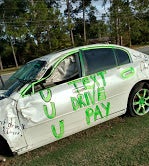Vienna Woman’s Club Campaigns Against Distracted Driving
Published 11:14 am Wednesday, October 18, 2017
Staff Reports
Cordele Dispatch
VIENNA — The Vienna Woman’s Club has partnered with Mixon’s Wrecker Service to send out a message against distracted driving. During Dooly County High School’s Homecoming Week celebration, a vehicle wrecked during a recent chase with law enforcement is on display in front of the school on Third Street in Vienna to remind motorists, especially teen drivers, about the dangers of distracted driving. The wrecked vehicle is colorfully tagged with warnings against distracted driving in the hopes of catching the teen drivers’ attention.
Georgia has implemented a total cell phone ban while driving for all drivers under the age of 18 with instruction permits or Class D licenses. Violators are subject to a $150 fine and one point on the driving record. Fines will be doubled if the violator is involved in prohibited behavior at the time of a traffic crash.
Since July 1, 2010, all Class C licensed drivers, regardless of age, are prohibited from texting while driving.
The law forbids drivers from using a cell phone, text messaging device, personal digital assistant (PDA), computer, or similar wireless device to write, send, or read text data while driving. The ban applies to text messages, instant messages (IM), email, and Internet data. The law creates exceptions for emergency personnel, drivers responding to emergencies, and drivers who are fully parked. Georgia’s cell phone and texting laws are considered “primary” laws, meaning an officer can pull you over for the offense without having to witness some other violation. That is, the officer sees you texting and issues a citation. The penalty for breaking this law includes a $150 fine and one point on the driving record.
In a study conducted by the Virginia Tech Transportation Institute (VTTI) and the National Highway Traffic Safety Administration (NHTSA) researchers found about 80 percent of crashes were caused by some form of distraction– like cell phone use or being tired—occurring within three seconds of the incident.
Distracted driving involves driving while doing another activity that takes your attention away from driving.
This may include things like using a cell phone, texting, eating, drinking, and talking with passengers. It doesn’t take a rocket scientist to predict that cell phone use is the most common driving distraction that has emerged from 21st century technology.
Other activities have been found to be just as distracting or even more capable of increasing crash occurrences and here’s how they rank: reaching for a moving object, increases crash risk by 9 times; looking at an object outside the vehicle increases crash risk by 3.7 times; reading increases crash risk by 3 times; grooming or applying makeup increases crash risk by 3 times; using a hand-held device like a GPS increases crash risk by 3 times; talking or listening to a hand-held cell phone increases crash risk by 1.3 times; and drowsiness, a tired driver behind the wheel, increases crash risk by 4 times. Driving while distracted is serious and life-threatening.
The AAA Foundation for Traffic Safety suggests several tips for being a “heads” up driver including: planning ahead, stowing electronic devices, preparing children or pets for a trip, avoiding eating while driving, storing loose gear, and staying focused on the driving task.



